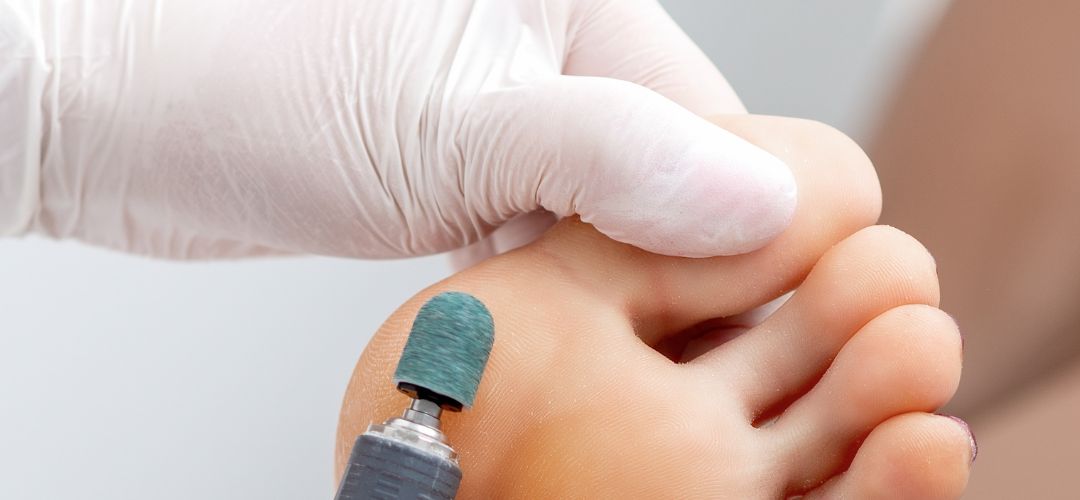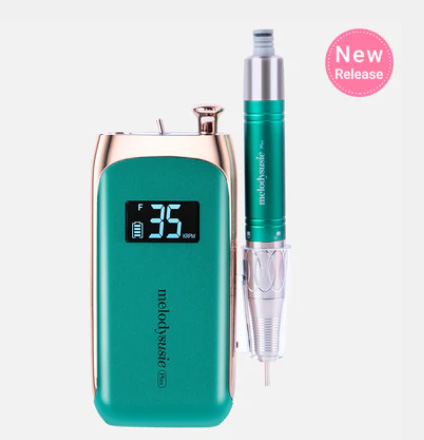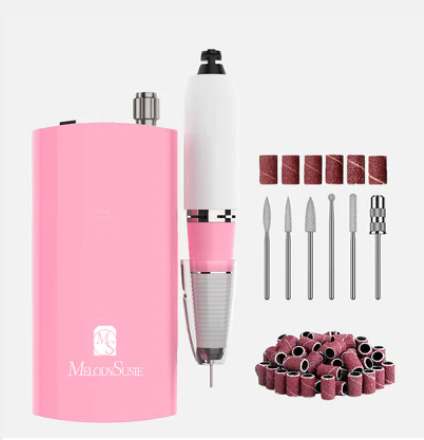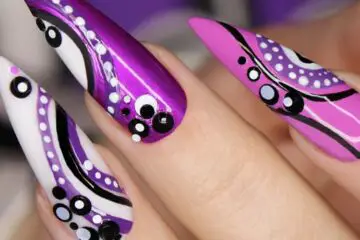How do I use a nail drill for removing dead skin? | Have you ever wanted to remove your dead skin with a nail drill? Well, now you can! Using a nail drill for removing dead skin is an easy and effective way to buff away dry, rough patches or even peeling areas from your hands and feet. This article will teach you how to safely use a nail drill for removing dead skin.
First, make sure that you have the right tools for the job. You will need a nail drill, some sandpaper or buffing pads, and some moisturizer. Additionally, make sure to wear protective goggles as well as gloves when using the drill.
Next, plug in your nail drill and set it to its lowest speed setting. Slowly move the bit across the area that you want to buff away dead skin from. Make sure that the bit is kept moving at all times, and keep your hands away from the spinning bit of the drill. After a few passes, you should see a smooth surface with no rough patches remaining.
Once you’ve finished buffing away the dry skin, it’s time to apply some moisturizer. Choose a cream or lotion that is specifically designed for dry skin and apply it generously to the area you’ve buffed with your nail drill. This will help keep your skin hydrated and prevent further dryness from occurring.
Finally, be sure to clean up after yourself! Disconnect the nail drill and dispose of any used sandpaper or buffing pads. Wipe down the bit and the base of the drill to ensure that they are clean before putting them away.
Using a nail drill for removing dead skin is a simple, quick way to get rid of dry, rough patches on your hands and feet. With just a few steps and precautions, you can have smoother skin in no time!

What do salons use to remove dead skin?
In a professional setting, salons and spas typically use a pedicure drill to remove dead skin. This type of machine uses special tips that rotate quickly and gently, buffing away dry skin without causing any harm or discomfort. The technician may also use a pumice stone for deeper exfoliation.
Nail drills are the most common tool that salons use for removing dead skin cells. These tools have a spinning bit at the end which is used to precisely remove small amounts of unwanted dry patches from the feet and hands. The nail drill can be adjusted to different speeds depending on the level of precision required. It is important to use the correct speed for the task at hand and to keep the bit moving in order to avoid over-buffing or damaging the skin.
Why is removing dead skin good?
Removing dead skin cells is an important part of maintaining healthy and youthful-looking skin. Dead skin cells can accumulate on the surface of the skin, blocking out moisture and trapping bacteria in its pores. This can lead to clogged pores, breakouts, and other types of irritation.
In addition to promoting healthier looking skin, removing dead skin helps protect against sun damage. Sun rays can penetrate through dead skin cells, causing harmful UV exposure that can damage the skin and increase the risk of wrinkles, age spots, and other signs of premature aging. Removing dead skin cells helps create an even surface for sunscreen to work more effectively.
Regularly removing dead skin also helps to boost circulation on the surface of the skin. This increases the flow of oxygen and nutrient-rich blood to the outer layers of the skin, which helps improve overall texture and tone.
Finally, removing dead skin can help reduce rough patches on the hands and feet. It’s common for dry areas to accumulate on these parts of the body due to changes in temperature or aging. Removing these stubborn patches with a nail drill can help make them softer and smoother.
What happens if you don’t remove dead skin?
Without removing dead skin, it can quickly accumulate on the surface of the skin and lead to a number of issues. Clogged pores are one of the main problems associated with not removing dead skin cells. Without regular exfoliation, dirt and bacteria become trapped in the pores, leading to breakouts and other types of irritation.
Leaving dead skin to accumulate on the surface of skin can also lead to premature aging. Sun rays can penetrate through the buildup of dead skin cells, increasing the risk of wrinkles and age spots. This makes it more difficult for sunscreen to work effectively and can cause other types of sun damage in addition to premature aging.
By not removing dead skin regularly, you could be preventing essential nutrients from reaching the outer layers of skin. This can cause a number of issues, such as dryness, discoloration, and an uneven texture or tone. Furthermore, if dead skin is left to accumulate on parts of the body like hands and feet, it could lead to rough patches that are difficult to remove without professional help.
Overall, removing dead skin regularly with a
What happens if dead skin is not removed? (potential issues)
- Clogged pores
- Breakouts and irritation
- Premature aging
- Uneven skin texture and tone
- Difficulty spreading sunscreen effectively
- Sun damage
- Dryness, discoloration, and rough patches on hands and feet.
nail drill can help prevent many of these issues. It is important to use a nail drill properly in order to avoid damaging the skin and causing further irritation.
How often should I remove dead skin?
The frequency of exfoliation with a nail drill depends on your skin type and age. Generally, those with normal skin should exfoliate once or twice a week, while those with oily skin can get away with once or twice every two weeks. For those with dry or sensitive skin types, it is best to avoid using the nail drill too often as this can cause further irritation.
Younger individuals with less sensitive skin may find that they can exfoliate more frequently than those with older, drier skin types. It is always important to listen to your skin and adjust the frequency of exfoliation accordingly.
It is also important to note that it not only the frequency of exfoliation that matters but also the intensity. Those with sensitive or aging skin should take extra care to use a gentle speed and pressure setting to avoid further irritation or damage to the skin.
It is also important to note that exfoliation with a nail drill should not be used as a substitute for proper skin care hygiene. Cleansing and moisturizing the skin on a regular basis are still essential steps in maintaining healthy, youthful-looking skin.
In addition, it is best to avoid excessive sun exposure when using a nail drill for dead skin removal, as this can further irritate the skin. Make sure to wear sunscreen with an SPF of 30 or higher and a hat when outdoors.
What is the best tool for removing dead skin from feet?
Using a nail drill to remove dead skin from feet is an effective and convenient way to exfoliate. This method of exfoliation can be used both on wet and dry skin, making it suitable for different lifestyles. It is also less abrasive than traditional methods of foot exfoliation, so your feet are not left feeling raw or dry afterwards.
When removing dead skin from feet with a nail drill, it is important to take the time to choose the right tool. The type of nail drill you use will depend on your skin type as well as the degree of exfoliation you want to achieve. For example, those with dry or sensitive skin may wish to opt for an adjustable speed setting and a gentler head to avoid further irritation.
It is also important to take the time to prepare your feet for exfoliation. Soaking the feet in warm water beforehand will help soften and loosen any stubborn dead skin cells, making them easier to remove. To ensure a smooth experience, it is best to use a good quality foot scrub or pumice stone before using the nail drill.
Why do feet collect so much dead skin?
Feet are one of the most common areas on the body where dead skin accumulates. This is because feet are constantly exposed to pressure and friction due to their constant use in walking, running, and standing. This causes the skin on our feet to become thicker over time as a natural protective response, which is why callouses form on certain parts of our feet.
However, this increased thickness of the skin on our feet also leads to an accumulation of dead skin cells. This is because thicker skin does not shed as quickly as normal, meaning that new skin cells are unable to push old ones out and they become trapped in the layers of the foot.
Another factor leading to a buildup of dead skin on our feet is hygiene. Feet are constantly exposed to bacteria and dirt, which can block the pores of the skin, making it difficult for old cells to get out. Additionally, if you do not wear properly-fitting shoes or socks, you may be trapping extra old cells on your feet as these clothes don’t always provide enough ventilation for them to escape.
To prevent a buildup of dead skin on your feet, it is important to maintain proper foot hygiene. This includes washing and moisturizing the feet regularly, exfoliating them using a foot scrub or pumice stone at least once per week, and wearing proper fitting shoes and socks. Additionally, keeping your nails trimmed short will help reduce the amount of pressure placed on the skin around them and will keep dirt or bacteria from collecting underneath them.
However, if a buildup of dead skin has already happened on your feet, you may want to consider using a nail drill for removing it. A nail drill is an electric tool that uses metal bits to gently exfoliate the hardened layers of skin around the nails. This tool is great for getting rid of any stubborn callouses or dry patches on the feet.
When using a nail drill for removing dead skin, you should start with a low speed first. This will help to ensure that only the outer layers of the skin are removed and will reduce the risk of causing any damage to your feet. Additionally, it is important to keep your hands and feet moisturized when using a nail drill to prevent blisters or dryness.
Finally, be sure to clean the tool after each use and sanitize it with rubbing alcohol to avoid the spread of any infections. With proper hygiene and care, a nail drill can help you keep your feet feeling smooth and looking great!
Is hard skin on feet bad?
When it comes to the health of your feet, hard skin is more than just a cosmetic issue. While some dryness and callouses are normal, excessive amounts of hardened skin can be an indicator that something is wrong.
Excessive hardening of the skin on your feet can occur due to excessive friction or pressure placed on the area. This could be the result of wearing ill-fitting shoes or from standing in one place for long periods of time. Poor hygiene can also contribute to the buildup of hard skin, as dead skin cells and bacteria may accumulate around the nails if they are not regularly washed and moisturized.
If left untreated, excessive hardening of the skin on your feet can cause discomfort and lead to the development of painful conditions such as blisters, corns, and calluses.
The good news is that hard skin on feet can be easily managed with regular foot care practices. This includes keeping your nails trimmed and filed to reduce pressure from ill-fitting footwear, wearing properly fitting shoes, wearing open-toed sandals when possible, and using a nail drill or pumice stone to gently remove excess dead skin. Additionally, you can help keep your feet healthy by regularly cleaning and moisturizing them with lukewarm water and a hydrating foot cream.
Conclusion | How do I use a nail drill for removing dead skin?
This article explains how hard skin on feet can cause discomfort and lead to the development of painful conditions such as blisters, corns, and calluses. It also provides instructions for using a nail drill for removing dead skin. Other foot care practices mentioned include keeping nails trimmed and filed, wearing properly fitting shoes, wearing open-toed sandals when possible, cleaning and moisturizing feet with lukewarm water and foot cream, and avoiding excessive friction or pressure on the skin. By following these steps, it is possible to manage hard skin on feet effectively.





